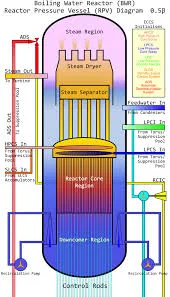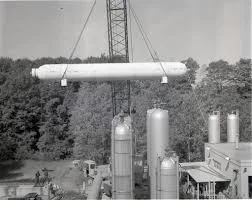Definition: In pressure vessels, the wall thickness is a critical factor in ensuring safe operation. It's designed to withstand the internal pressure exerted by the contained fluid or gas without exceeding the material's allowable stress limit, preventing vessel rupture or deformation.
Click the Translate button(see right) on this post to set your Own Language to understand more perfectly!!
Pressure Vessel Thickness Calculator
Pressure Vessel Thickness Calculator
Continue Definition:
Pressure Vessel Thickness
In pressure vessels, the wall thickness is a critical factor in ensuring safe operation. It's designed to withstand the internal pressure exerted by the contained fluid or gas without exceeding the material's allowable stress limit, preventing vessel rupture or deformation.
Formula:
Internal Pressure (P): This represents the maximum pressure the vessel will experience during operation, measured in units like pounds per square inch (psi) or megapascals (MPa).
Vessel Diameter (D): This is the internal diameter of the cylindrical pressure vessel, typically expressed in inches (in) or millimeters (mm).
Allowable Stress (S): This is the maximum stress the vessel material can safely handle without permanent deformation or failure. It's determined by the material properties and a safety factor applied to account for potential manufacturing imperfections, corrosion, and other factors. Allowable stress is usually specified in the same units as pressure (psi or MPa).
Calculation:
The formula for calculating the minimum required thickness is:
t = (P * D) / (2 * S)
Explanation:
P * D: This term represents the total force exerted by the internal pressure on the vessel wall. It's calculated by multiplying the pressure by the area of the cylindrical wall (pressure x diameter).
2 * S: This term represents the vessel's resistance to the internal pressure. It's calculated by multiplying the allowable stress by a factor of 2 to account for the fact that the pressure acts on both the inner and outer surfaces of the vessel wall.
Important Considerations:
This formula is generally applicable to thin-walled pressure vessels, where the ratio of the vessel diameter (D) to the wall thickness (t) is greater than or equal to 10. For thick-walled vessels, more complex calculations are needed.
The allowable stress (S) should be obtained from a reliable source, such as material standards or engineering codes like ASME Boiler and Pressure Vessel Code (ASME BPVC).
In practice, a corrosion allowance is often added to the calculated thickness to account for potential material degradation over time. This additional thickness ensures the vessel remains safe throughout its design life.
Safety factors are typically incorporated into the allowable stress or the formula itself to provide an extra margin of safety.
By following these guidelines and using appropriate materials and design practices, engineers can ensure that pressure vessels are safe and reliable for their intended applications.
Allowable Stress in Pressure Vessels
Definition:
Allowable stress, in the context of pressure vessels, is the maximum stress a material can safely withstand under operating conditions without experiencing permanent deformation or failure. It's a critical parameter in pressure vessel design, as it determines the vessel's wall thickness and, consequently, its ability to contain internal pressure.
Factors Affecting Allowable Stress:
Several factors influence the allowable stress of a material used in pressure vessels:
Material Properties: The inherent strength and ductility of the material play a major role. For example, high-strength steels generally have higher allowable stresses than low-strength materials.
Temperature: As temperature increases, most materials weaken. Therefore, the allowable stress for a material typically decreases as the operating temperature of the pressure vessel rises.
Fabrication Methods: The way a pressure vessel is manufactured can affect its material properties. For example, welding may introduce localized stresses that need to be considered when determining allowable stress.
Safety Factor: A safety factor is applied to account for potential manufacturing imperfections, corrosion, and other uncertainties. This factor reduces the allowable stress to a level that ensures safe operation.
Safety Factor Example:
Imagine a material with a yield strength (stress at which permanent deformation starts) of 70,000 psi. A common safety factor for pressure vessels might be 4. In this case, the allowable stress would be:
Allowable Stress = Yield Strength / Safety Factor = 70,000 psi / 4 = 17,500 psi
Finding Allowable Stress Values:
Allowable stress values for various materials are not universal constants. They are typically obtained from:
Material Standards: Organizations like ASTM International (ASTM) publish standards that specify material properties, including allowable stress values for different temperatures and applications.
Engineering Codes: Codes like the ASME Boiler and Pressure Vessel Code (ASME BPVC) provide allowable stress values for specific materials used in pressure vessel construction. These codes consider factors like safety factors and appropriate design practices.
List of Allowable Stress (for Informational Purposes):
Material, Allowable Stress Range (psi)
Carbon Steel (SA 516 Gr. 70), 15,000 - 25,000 (depending on temperature)
Stainless Steel (SA 304), 17,000 - 12,000 (depending on temperature)
Nickel Alloy (Monel 400), 20,000 - 13,000 (depending on temperature)
Aluminum Alloy (AA 6061), 9,000 - 7,000 (depending on temperature)
Relation between Psi & MPa
The conversion between psi (pounds per square inch) and MPa (megapascals) is a unit conversion factor. Here's how to convert between them:
1 MPa = 145.038 psi (approximately)
1 psi = 0.00689 MPa (approximately)
To convert psi to MPa:
Multiply the psi value by 0.00689.
Example:
Convert 500 psi to MPa.
500 psi * 0.00689 MPa/psi = 3.447 MPa (approximately)
To convert MPa to psi:
Multiply the MPa value by 145.038.
Example:
Convert 2 MPa to psi.
2 MPa * 145.038 psi/MPa = 290.076 psi (approximately)
Important Note:
The listed allowable stress values are for informational purposes only and should not be used for actual pressure vessel design. Always consult the relevant material standards or engineering codes for the specific allowable stress values applicable to your chosen material, operating temperature, and pressure vessel design code.
How it is possible to Earn Money Using the knowledge of Pressure Vessel Thicknes calculation in our real life????
There are several ways you can leverage your knowledge of pressure vessel thickness calculation to earn money in real life. Here are some potential avenues:
1. Pressure Vessel Design and Engineering:
Consulting Engineer: Offer your services as a consultant to companies that design and manufacture pressure vessels. You can help them calculate required wall thicknesses, review designs for safety compliance, and ensure vessels meet industry standards.
Freelance Design Work: Take on freelance projects for pressure vessel design. This could involve creating detailed drawings, specifying materials, and performing calculations for custom-built vessels.
Engineering Firm Employment: Look for employment opportunities at engineering firms specializing in pressure vessel design. Your knowledge of thickness calculations would be valuable for various stages of the design process.
2. Inspection and Certification Services:
Pressure Vessel Inspector: Become a certified pressure vessel inspector and conduct inspections on existing vessels to ensure they meet safety regulations and haven't degraded over time. Your thickness calculation skills would be crucial for evaluating the vessel's integrity.
Quality Assurance/Control Engineer: Work in quality assurance or control for companies that manufacture pressure vessels. You would help ensure vessels meet design specifications and perform necessary thickness verification during production.
3. Software Development and Training:
Pressure Vessel Design Software Development: If you have programming skills, you could develop software that automates pressure vessel thickness calculations and design tasks. This software could be marketed to engineers and companies in the industry.
Pressure Vessel Design Training: Offer training courses or workshops on pressure vessel design principles, including thickness calculations. Your expertise would be valuable for engineers, technicians, and anyone involved in the pressure vessel industry.
4. Online Services and Content Creation:
Freelance Engineering Services: Offer online freelance services related to pressure vessel thickness calculations. This could involve providing design consultations, creating design templates, or solving specific thickness calculation problems for clients.
Educational Content Creation: Develop educational materials (articles, tutorials, videos) on pressure vessel design and thickness calculations. You could monetize this content through subscriptions, advertising, or online courses.
Additional Considerations:
Formal Education and Certification: While not always mandatory, depending on your chosen field, pursuing a relevant engineering degree or certification in pressure vessel design can bolster your qualifications and open up more opportunities.
Staying Up-to-Date: Pressure vessel design codes and regulations are constantly evolving. Staying updated on the latest standards and best practices is crucial for providing accurate and reliable services.
Networking: Building connections with engineers, inspectors, and companies in the pressure vessel industry can open doors to potential job opportunities or freelance clients.
By effectively utilizing your knowledge of pressure vessel thickness calculation, you can carve out a niche in various engineering and technical fields. Remember to leverage your expertise strategically to build a successful career path.
Do YOU Want To Earn Money In Various Ways, Click The Link & Explore Your Field of Interest!!!














No comments:
Post a Comment